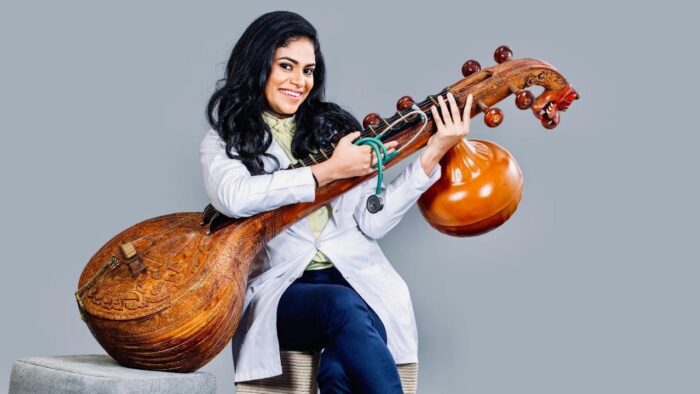Dr Shanta V always emphasised on the need for a good patient-physician relationship and that it must go beyond a pen and pad. But with the growing number of patients, it is difficult for most doctors to maintain that relationship. According to WHO, the ratio of patients to doctors must be 1:1000, but in India, the ratio is 1:1500, causing severe burnout in doctors. Apart from doctors, healthcare staff in hospitals and other institutions also undergo stress and mental health issues.
In this two part-interview with Dr Tara Rajendran, physician and musician, she speaks to us about inculcating music into India's palliative oncology. Having worked with various medical centers in India, and the US (Harvard and Stanford), she has understood the necessity and the significance music holds with respect to health management. Currently, she is pursuing her doctoral education in the ‘Evolution of the use of Indian classical music in medicine’.
“In the last two decades there has been tremendous data-base on the role of musical interventions in cancer care, which includes mitigating anxiety, enhancing sleep quality, and reducing cancer related fatigue,” she said. If integrative oncology services including the music therapy can be incorporated right from the beginning of the treatment, it may improve the patient experience.
Dr Tara learnt carnatic music as a child from the age of six, both vocal and the veena. It is interesting to note that the Saraswati Veena shares anatomical similarities with the human vertebral column. This finding can be found mentioned in two Kannada books published in 1936 by Yeda Torey Subramanya Sharma- ‘Sandhya Vandaniya Tavartha’ and ‘Veda Prakashike’.
Going slightly off-track to give you a glimpse of the similarity-
The vertebral column has 24 presacral vertebrae, while the Veena has 24 frets. The spinal cord runs parallel to the vertebral column just like the strings of the veena run parallel to the frets. The size of the 24 presacral vertebrae increases towards the tail bone just as the size of the 24 frets increases as it goes towards the dragonhead. Both the dragon head and the tailbone have a slight curvature. Finally, the primary resonator of the veena is just like the human brain, amplifying the signals. Sir CV Raman, Nobel laureate in Physics, in one of his many publications mentioned the geometric significance and effect of the Veena’s bridge on the radiation of sound.

Picture credits: Saraswati Veena and the Veterbral Column
When she launched her advocacy lecture-concert series, Oncology and Strings, at the Stanford University Campus, she had an overwhelming response. When she reached Stanford, she was provided accommodation by the University, and for two months, she lived with a Native American family. “When I have a concert, I am usually accompanied by my uncle. They welcome the guests and help set up the stage. The family I lived with took the role of my uncle and cheered for me, and I was very touched,” Dr Tara reminisced.
She also mentioned a very interesting incident that happened on an uber drive, a couple of days before the concert, where she happened to meet this lady. "When I told her my name, she said ‘Tara’ means star, isn’t? I was surprised." The lady was fond of Bollywood movies and her favourite character from a film that she watched was Tara.
"Later on in the conversation, I found out that she was an actress and had played a role in the movie Venom. I invited her to my concert and she actually made it with her daughters and husband. After the concert, her daughters tried their hand at the veena. A few days later, I received her message about her buying a veena for herself and her daughters."
Dr Tara’s mentor from Stanford Cancer Center, who attended her lecture-concert, expressed that the veena recitation helped me relax and calm down after a very long day as an on-call doctor. That was the impact the Veena had on her listeners.
“India is home to a variety of music genres such as Carnatic, Hindustani, film songs, folk music, Khayal, Dhrupad and more. Each state has its own style of music. The grammar associated with classical music in India allows you to improvise a composition to any length. During a performance, there is the alap and tani avartanam all of which have been given room for improvisation. However, the same cannot be said for western classical music. Indian music is diverse and rich in melody”, commented Dr Tara.
Although we are home to this musical diversity, it is a pity that it is not used to its maximum therapeutic potential. If we view Indian classical music from the eyes of physics, it is a set of frequencies that can be aligned in a particular sequence to elicit different responses. For instance, the Raga Brindavani or Sudh Sarang elicits a romantic response, or the raga Neelambari gives one good sleep. Also, according to the time of the day, specific ragas are sung. Dr Tara is certain that there are ragas that help in pain management and other physiological activities in the body.
"The number of high quality, unbiased, blinded randomized controlled trials using Indian music are limited. Medical students and clinicians must be encouraged do well-designed randomized controlled trials (RCTs) to create evidence base for musical interventions that are tailored to Indian sub-continent. It can cause a ripple effect and more studies can be conducted. We need to create an extensive clinical evidence-base using our indigenous music, the music people of India would connect with the most”, explained Dr Tara.
Apart from conducting more studies, Dr Tara also emphasised on the need to have collaborative expertise from different fields of integrative oncology.




